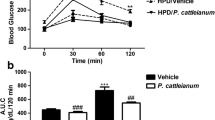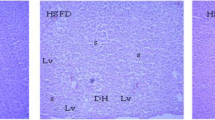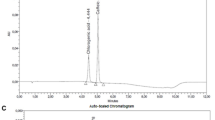Abstract
Obesity is a multifactorial disease that comes from an imbalance between food intake and energy expenditure. Moreover, studies have shown a relationship between mitochondrial dysfunction and obesity. In the present study, we investigated the effect of acerola juices (unripe, ripe, and industrial) and its main pharmacologically active components (vitamin C and rutin) on the activity of enzymes of energy metabolism in the brain of mice fed a palatable cafeteria diet. Two groups of male Swiss mice were fed on a standard diet (STA) or a cafeteria diet (CAF) for 13 weeks. Afterwards, the CAF-fed animals were divided into six subgroups, each of which received a different supplement for one further month (water, unripe, ripe or industrial acerola juices, vitamin C, or rutin) by gavage. Our results demonstrated that CAF diet inhibited the activity of citrate synthase in the prefrontal cortex, hippocampus, and hypothalamus. Moreover, CAF diet decreased the complex I activity in the hypothalamus, complex II in the prefrontal cortex, complex II–III in the hypothalamus, and complex IV in the posterior cortex and striatum. The activity of succinate dehydrogenase and creatine kinase was not altered by the CAF diet. However, unripe acerola juice reversed the inhibition of the citrate synthase activity in the prefrontal cortex and hypothalamus. Ripe acerola juice reversed the inhibition of citrate synthase in the hypothalamus. The industrial acerola juice reversed the inhibition of complex I activity in the hypothalamus. The other changes were not reversed by any of the tested substances. In conclusion, we suggest that alterations in energy metabolism caused by obesity can be partially reversed by ripe, unripe, and industrial acerola juice.








Similar content being viewed by others
References
WHO (2015) WHO | Obesity and overweight. World Heal Organ
Milanski M, Degasperi G, Coope A et al (2009) Saturated fatty acids produce an inflammatory response predominantly through the activation of TLR4 signaling in hypothalamus: implications for the pathogenesis of obesity. J Neurosci 29:359–370. doi:10.1523/JNEUROSCI.2760-08.2009
Moraes JC, Coope A, Morari J et al (2009) High-fat diet induces apoptosis of hypothalamic neurons. PLoS One 4:e5045. doi:10.1371/journal.pone.0005045
Velloso LA, Schwartz MW (2011) Altered hypothalamic function in diet-induced obesity. Int J Obes 35:1455–1465. doi:10.1038/ijo.2011.56
Thaler JP, Yi C-X, Schur EA et al (2012) Obesity is associated with hypothalamic injury in rodents and humans. J Clin Invest 122:153–162. doi:10.1172/JCI59660
van de Sande-Lee S, Velloso LA (2012) Disfunção hipotalâmica na obesidade. Arq Bras Endocrinol Metabol 56:341–350. doi:10.1590/S0004-27302012000600001
Williams LM (2012) Hypothalamic dysfunction in obesity. Proc Nutr Soc 71:521–533. doi:10.1017/S002966511200078X
Keaney JF, Larson MG, Vasan RS et al (2003) Obesity and systemic oxidative stress: clinical correlates of oxidative stress in the Framingham Study. Arterioscler Thromb Vasc Biol 23:434–439. doi:10.1161/01.ATV.0000058402.34138.11
Furukawa S, Fujita T, Shimabukuro M et al (2004) Increased oxidative stress in obesity and its impact on metabolic syndrome. J Clin Invest 114:1752–1761. doi:10.1172/JCI21625
Noeman SA, Hamooda HE, Baalash AA (2011) Biochemical study of oxidative stress markers in the liver, kidney and heart of high fat diet induced obesity in rats. Diabetol Metab Syndr 3:17. doi:10.1186/1758-5996-3-17
Barouch LA, Gao D, Chen L et al (2006) Cardiac myocyte apoptosis is associated with increased DNA damage and decreased survival in murine models of obesity. Circ Res 98:119–124. doi:10.1161/01.RES.0000199348.10580.1d
Al-Aubaidy HA, Jelinek HF (2011) Oxidative DNA damage and obesity in type 2 diabetes mellitus. Eur J Endocrinol 164:899–904. doi:10.1530/EJE-11-0053
Freeman LR, Zhang L, Nair A et al (2013) Obesity increases cerebrocortical reactive oxygen species and impairs brain function. Free Radic Biol Med 56:226–233. doi:10.1016/j.freeradbiomed.2012.08.577
Matsuda M, Shimomura I (2013) Increased oxidative stress in obesity: implications for metabolic syndrome, diabetes, hypertension, dyslipidemia, atherosclerosis, and cancer. Obes Res Clin Pract 7:e330–e341
Ma W, Yuan L, Yu H et al (2014) Mitochondrial dysfunction and oxidative damage in the brain of diet-induced obese rats but not in diet-resistant rats. Life Sci 110:53–60. doi:10.1016/j.lfs.2014.07.018
Ritov VB, Menshikova EV, He J et al (2005) Deficiency of subsarcolemmal mitochondria in obesity and type 2 diabetes. Diabetes 54:8–14
Sparks LM, Xie H, Koza RA et al (2005) A high-fat diet coordinately downregulates genes required for mitochondrial oxidative phosphorylation in skeletal muscle. Diabetes 54:1926–1933
Rong JX, Qiu Y, Hansen MK et al (2007) Adipose mitochondrial biogenesis is suppressed in db/db and high-fat diet-fed mice and improved by rosiglitazone. Diabetes 56:1751–1760. doi:10.2337/db06-1135
Navarro A, Boveris A (2007) The mitochondrial energy transduction system and the aging process. Am J Physiol Cell Physiol 292:C670–C686. doi:10.1152/ajpcell.00213.2006
Halliwell B (2006) Oxidative stress and neurodegeneration: where are we now? J Neurochem 97:1634–1658. doi:10.1111/j.1471-4159.2006.03907.x
Mazza M, Pomponi M, Janiri L et al (2007) Omega-3 fatty acids and antioxidants in neurological and psychiatric diseases: an overview. Prog Neuropsychopharmacol Biol Psychiatry 31:12–26. doi:10.1016/j.pnpbp.2006.07.010
Halliwell B, Whiteman M (2004) Measuring reactive species and oxidative damage in vivo and in cell culture: how should you do it and what do the results mean? Br J Pharmacol 142:231–255. doi:10.1038/sj.bjp.0705776
Birben E, Sahiner UM, Sackesen C et al (2012) Oxidative stress and antioxidant defense. World Allergy Org J 5:9–19. doi:10.1097/WOX.0b013e3182439613
Avignon A, Hokayem M, Bisbal C, Lambert K (2012) Dietary antioxidants: do they have a role to play in the ongoing fight against abnormal glucose metabolism? Nutrition 28:715–721. doi:10.1016/j.nut.2012.01.001
Valdecantos MP, Pérez-Matute P, Martínez JA (2009) Obesity and oxidative stress: role of antioxidant supplementation. Rev Invest Clin 61:127–139
Alfadda AA, Sallam RM (2012) Reactive oxygen species in health and disease. J Biomed Biotechnol 2012:936486. doi:10.1155/2012/936486
Oliveira LDS, Moura CFH, De Brito ES et al (2012) Antioxidant metabolism during fruit development of different acerola (Malpighia emarginata D.C) clones. J Agric Food Chem 60:7957–7964. doi:10.1021/jf3005614
Mezadri T, Fernández-Pachón MS, Villaño D et al (2006) The acerola fruit: composition, productive characteristics and economic importance. Arch Latinoam Nutr 56:101–109
Franke SI, Pra D, da Silva J et al (2005) Possible repair action of vitamin C on DNA damage induced by methyl methanesulfonate, cyclophosphamide, FeSO4 and CuSO4 in mouse blood cells in vivo. Mutat Res 583:75–84. doi:10.1016/j.mrgentox.2005.03.001
La Casa C, Villegas I, Alarcon de la Lastra C et al (2000) Evidence for protective and antioxidant properties of rutin, a natural flavone, against ethanol induced gastric lesions. J Ethnopharmacol 71:45–53
Leffa DD, da Silva J, Daumann F et al (2014) Corrective effects of acerola (Malpighia emarginata DC.) juice intake on biochemical and genotoxical parameters in mice fed on a high-fat diet. Mutat Res Mol Mech Mutagen 770:144–152. doi:10.1016/j.mrfmmm.2013.11.005
Shafat A, Murray B, Rumsey D (2009) Energy density in cafeteria diet induced hyperphagia in the rat. Appetite 52:34–38. doi:10.1016/j.appet.2008.07.004
Dias FM, Leffa DD, Daumann F et al (2014) Acerola (Malpighia emarginata DC.) juice intake protects against alterations to proteins involved in inflammatory and lipolysis pathways in the adipose tissue of obese mice fed a cafeteria diet. Lipids Health Dis 13:24. doi:10.1186/1476-511X-13-24
Lowry OH, Rosebrough NJ, Farr AL, Randall RJ (1951) Protein measurement with the Folin phenol reagent. J Biol Chem 193:265–275
Srere PA (1969) Citrate synthase. Methods Enzymol 13:3–11
Fischer JC, Ruitenbeek W, Berden JA et al (1985) Differential investigation of the capacity of succinate oxidation in human skeletal muscle. Clin Chim Acta 153:23–36
Cassina A, Radi R (1996) Differential inhibitory action of nitric oxide and peroxynitrite on mitochondrial electron transport. Arch Biochem Biophys 328:309–316. doi:10.1006/abbi.1996.0178
Rustin P, Chretien D, Bourgeron T et al (1994) Biochemical and molecular investigations in respiratory chain deficiencies. Clin Chim Acta 228:35–51
Hughes BP (1962) A method for the estimation of serum creatine kinase and its use in comparing creatine kinase and aldolase activity in normal and pathological sera. Clin Chim Acta 7:597–603
Schwartz MW, Woods SC, Porte D et al (2000) Central nervous system control of food intake. Nature 404:661–671. doi:10.1038/35007534
Moullé VS, Picard A, Cansell C et al (2015) Role of brain lipid sensing in nervous regulation of energy balance. Méd Sci 31:397–403. doi:10.1051/medsci/20153104014
Camer D, Yu Y, Szabo A et al (2015) Bardoxolone methyl prevents high-fat diet-induced alterations in prefrontal cortex signalling molecules involved in recognition memory. Prog Neuropsychopharmacol Biol Psychiatry 59:68–75. doi:10.1016/j.pnpbp.2015.01.004
Pratchayasakul W, Sa-nguanmoo P, Sivasinprasasn S et al (2015) Obesity accelerates cognitive decline by aggravating mitochondrial dysfunction, insulin resistance and synaptic dysfunction under estrogen-deprived conditions. Horm Behav 72:68–77. doi:10.1016/j.yhbeh.2015.04.023
Nunes Rda S, Kahl VF, Sarmento Mda S et al (2011) Antigenotoxicity and antioxidant activity of acerola fruit (Malpighia glabra L.) at two stages of ripeness. Plant Foods Hum Nutr 66:129–135. doi:10.1007/s11130-011-0223-7
Puchau B, Zulet MA, de Echávarri AG et al (2010) Dietary total antioxidant capacity is negatively associated with some metabolic syndrome features in healthy young adults. Nutrition 26:534–541. doi:10.1016/j.nut.2009.06.017
Leffa DD, da Silva J, Petronilho FC et al (2015) Acerola (Malpighia emarginata DC.) juice intake protects against oxidative damage in mice fed by cafeteria diet. Food Res Int 77:649–656. doi:10.1016/j.foodres.2015.10.006
Dandona P, Ghanim H, Bandyopadhyay A et al (2010) Insulin suppresses endotoxin-induced oxidative, nitrosative, and inflammatory stress in humans. Diabetes Care 33:2416–2423. doi:10.2337/dc10-0929
Carbonell T, Rama R (2007) Iron, oxidative stress and early neurological deterioration in ischemic stroke. Curr Med Chem 14:857–874
Adam-Vizi V (2005) Production of reactive oxygen species in brain mitochondria: contribution by electron transport chain and non-electron transport chain sources. Antioxid Redox Signal 7:1140–1149. doi:10.1089/ars.2005.7.1140
García-Cazorla A, Wolf NI, Serrano M et al (2009) Mental retardation and inborn errors of metabolism. J Inherit Metab Dis 32:597–608. doi:10.1007/s10545-009-0922-5
Schreckinger ME, Lotton J, Lila MA, de Mejia EG (2010) Berries from South America: a comprehensive review on chemistry, health potential, and commercialization. J Med Food 13:233–246. doi:10.1089/jmf.2009.0233
Nunes RDS, Kahl VFS, Sarmento MDS et al (2013) Genotoxic and antigenotoxic activity of acerola (Malpighia glabra L.) extract in relation to the geographic origin. Phytother Res 27:1495–1501. doi:10.1002/ptr.4896
Kurzawa-Zegota M, Najafzadeh M, Baumgartner A, Anderson D (2012) The protective effect of the flavonoids on food-mutagen-induced DNA damage in peripheral blood lymphocytes from colon cancer patients. Food Chem Toxicol 50:124–129. doi:10.1016/j.fct.2011.08.020
Kamalakkannan N, Stanely Mainzen Prince P (2006) Rutin improves the antioxidant status in streptozotocin-induced diabetic rat tissues. Mol Cell Biochem 293:211–219. doi:10.1007/s11010-006-9244-1
Guo R, Wei P, Liu W (2007) Combined antioxidant effects of rutin and vitamin C in Triton X-100 micelles. J Pharm Biomed Anal 43:1580–1586. doi:10.1016/j.jpba.2006.11.029
Charradi K, Elkahoui S, Karkouch I et al (2012) Grape seed and skin extract prevents high-fat diet-induced brain lipotoxicity in rat. Neurochem Res 37:2004–2013. doi:10.1007/s11064-012-0821-2
Leffa DD, Dos Santos CEI, Daumann F et al (2015) Effects of supplemental acerola juice on the mineral concentrations in liver and kidney tissue samples of mice fed with cafeteria diet. Biol Trace Elem Res. doi:10.1007/s12011-015-0276-9
Acknowledgments
We thank UNESC, CAPES, and CNPq for the financial support.
Author information
Authors and Affiliations
Corresponding author
Ethics declarations
Conflict of Interest
The authors declare that they have no competing interests.
Rights and permissions
About this article
Cite this article
Leffa, D.D., Rezin, G.T., Daumann, F. et al. Effects of Acerola (Malpighia emarginata DC.) Juice Intake on Brain Energy Metabolism of Mice Fed a Cafeteria Diet. Mol Neurobiol 54, 954–963 (2017). https://doi.org/10.1007/s12035-016-9691-y
Received:
Accepted:
Published:
Issue Date:
DOI: https://doi.org/10.1007/s12035-016-9691-y




